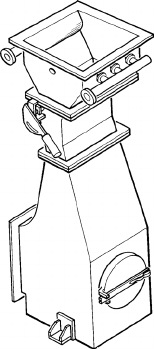171
19
Venturi Scrubbers
19.1 DEVICE TYPE
Venturi scrubbers are wet scrubbers that use a change in gas velocity to shear liquid
streams (usually water) into tiny target droplets into which particulate and soluble
gases are transferred. They are considered as a workhorse of the available air pol-
lution control technologies given their low capital cost, reliability, and effectiveness
on a variety of applications. They tend to use more energy than alternative designs,
particularly on applications treating over 50,000 actual cubic feet per minute (acfm)
of gases. Venturi scrubbers are used where the collected product can be handled wet.
They are often used on processes, such as calciners and dryers, wherein the blow-
down from the scrubber can be returned to a wet portion of the process. They can
also handle the heavy-dust loadings, which can occur from these sources. Venturi
scrubbers can ingest dust loadings of over 30 grs/dscf (grains per dry standard cubic
foot) if designed correctly. Figure19.1 shows a rectangular throat Venturi scrubber,
a workhorse of the wet scrubbing industry.
19.2 TYPICAL APPLICATIONS
Venturi scrubbers are best used to remove particulate 0.6 μm aerodynamic diameter
and larger where the gas ow is from 1 to 500,000 acfm if the particles are 10 μm
and larger, and from 1 to 50,000 acfm if the particles are 0.6 μm and larger. They
have been successfully used, however, to remove submicron particulate at pressure
drops of up to about 60 inches water column.
If the gas stream has primarily submicron particulate (say, from a hazardous
waste incinerator), a condensing wet scrubbing system, or a wet electrostatic precipi-
tator, or similar lower energy input system might be used instead.
There are literally hundreds of applications, however, in which the particulate is 1
to 20 μm diameter where the Venturi scrubber provides excellent results. The result
is that thousands of Venturi scrubbers are in daily use throughout the world.
Rectangular throat Venturis are commonly used on product dryers and calciners
where there is a wet stage. Mineral lime kilns and lime sludge kilns (such as in the
recausticizing section of a kraft pulp mill) often use Venturi scrubbers. Agricultural
product rotary dryers are often equipped with primary product-collecting cyclones,
which are followed by Venturi scrubbers. Grinding, milling (wet), mulling, and other
operations that generate dust often use Venturi scrubbers for particulate control.
Venturis on mineral lime kilns usually operate a 10 to 16 inch water column pres-
sure drop, and units on lime sludge kilns are designed to run at 22 to 26 inches water
column and sometimes higher if the lime mud being burned is high in sodium.

172 Air Pollution Control Equipment Selection Guide
Boilers such as those ring bagasse or bark are often equipped with Venturi scrub-
bers. The boiler usually incorporates a primary knock-out zone and cyclone collector
followed by a medium-energy Venturi (approximately 10 to 15 inches water column).
Some metallurgic furnaces are equipped with higher energy Venturi scrubbers
because the particles generated are smaller.
Annular Venturi scrubbers are used when the gas volume exceeds about 25,000
acfm. The reason for this is that designers like to maintain a throat width of 4 to 6
inches maximum. Sometimes a rectangular throat of this size would be too long to
suit the gas inlet. The throat is therefore wrapped around to form the annular type.
These designs are often seen on waste-burning boilers, larger kilns and calciners,
and large capacity dryers. Figure19.2 shows an annular Venturi scrubber designed
and built by TREMA in Europe. Note the ring-shaped liquid header at the top and
the throat positioner at the bottom.
Eductor Venturi scrubbers are used where the designer wants to eliminate the use
of a fan and is willing to use more liquid at higher pressure instead. These conditions
might prevail where space is limited, the source may be explosive (a fan wheel spark
could cause a problem), or the application requires simplicity. Eductors are used on
tank vent systems, on tools used in the manufacture of semiconductor products, on
odor control systems where fan noise may be an issue, and on emergency gas control
systems (such as for chlorine control).
Reverse jet scrubbers are used on these same applications with primary focus on
applications where the total energy input is an issue. They use a lower static pressure
fan but a higher pressure pump, but they have a lower total energy input in many cases.
19.3 OPERATING PRINCIPLES
All Venturi scrubbers operate by creating a dispersion of closely packed target drop-
lets into which the contaminant particulate is impacted. The droplet dispersion may
FIGURE19.1 Venturi scrubber (Bionomic Industries, Inc.).
Get Air Pollution Control Equipment Selection Guide, 2nd Edition now with the O’Reilly learning platform.
O’Reilly members experience books, live events, courses curated by job role, and more from O’Reilly and nearly 200 top publishers.

